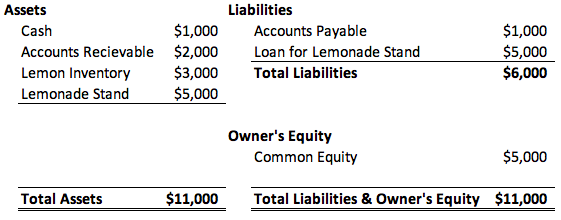While it may not be fun, understanding accounting terms are crucial as you begin investing or start a business.
![]()
The most important part of investing is knowing the price you’re paying versus the intrinsic value of the company. Simply put, the lower the price you pay relative to value, the more your investment will return over time.
Accounting revolves around this equation: Assets = Liabilities + Owner’s Equity.
To help with this example, I put together a balance sheet for a hypothetical lemon stand business:

With this simple scenario in mind, let’s walk through each of the accounting terms.
Assets
Assets are items that a company uses to make money. The point of sale happens at the lemonade stand, making this a fixed asset.
Not all assets are the same. The closer the asset is to cash, the more valuable they should be to you as an investor or business owner.
Here is the value of each asset based on their ability to convert to cash:
- Cash – no conversion is needed
- Marketable Securities – can be sold, but it may take a couple days
- Accounts Receivable – will convert to cash based on your company’s credit terms
- Inventory – it will take time to sell the lemons at your stand
- Fixed Assets – depends on the market for the lemonade stand
Liabilities
Liabilities are anything that a company owes money on. A loan for your lemonade stand would be a liability, as well as anything else you may own money on. Such as anything you owe for your lemon inventory.
Be wary of any companies that pile on too much debt. Too much debt prevents a company to adjust to new business trends. We have seen several retail stores such as Toys R Us close their doors because they had too much debt to compete with new entrants like Amazon.
In this example, it looks like the company took out a loan for the entire value of the lemonade stand. While this may look risky, the lemonade stand actually has $11,000 in assets relative to the $5,000 debt. It doesn’t seem like this company is getting greedy with debt.
Owner’s Equity
Owner’s Equity is owner’s share of assets in the company, which is also known as the company’s book value. Based on the lemonade stand’s assets and liabilities, the company has a book value of $5,000. Therefore, if the company’s assets were liquidated, and all liabilities were paid out, the shareholders of the lemonade stand would be entitled to $5,000.
When you look at investments, you may find companies that have a higher book value than their market valuation. While we recommend digging into the financials further to learn what assets the business has, companies like this have a very high margin of safety.
Summary of Accounting Terms
Hopefully this gives you a quick lesson in accounting terms. You don’t need a CPA to know what to look for, and this knowledge will help as you evaluate investments or start a business.
Keep an eye on the amount of debt and liabilities a business has. The more debt on the balance sheet, the more trouble the business will have adapting to changes.
Also, not all assets are the same. A ton of cash is worth a lot more than a ton of inventory. If a business has an incredibly high book value, dig into the types of assets they have to see how much value you could realize as an investor.